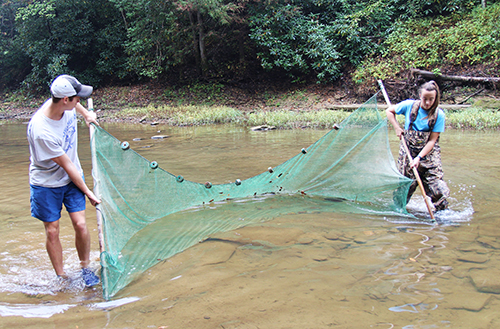Eisenhour researches fish in Red River
 Morehead State Professor of Biology Dr. David Eisenhour and student researchers have been working to identify fish species in an isolated section of the Red River.
Morehead State Professor of Biology Dr. David Eisenhour and student researchers have been working to identify fish species in an isolated section of the Red River.
Eisenhour and his students are documenting the different species of fish that live in an isolated part of the Red River, which goes through the Red River Gorge in Eastern Kentucky. They are studying the nine-mile stretch of the river between roads KY 746 and KY 715, known as the “Wild River” section of the waterway because of class II and class III rapids there.
“Access to the river is quite difficult, except for the upper and lower end (at the two highway crossings), so the only fish surveys in this region were at the upper-lower access points, in the early 1970s and late 1990s,” Eisenhour said. Those surveys identified 26 fish species in the area, and Eisenhour and biologists with Kentucky Nature Preserves (KNP), which partially funds his research, believed there were many more species of fish in that section of the river.
Eisenhour and several students sampled eight locations along the river using seining, a method of fishing using a net that hangs vertically in the water with its bottom edge held down by weights and its top edge buoyed by floats, and backpack electrofishing to identify fish they saw or captured, identifying an additional 15 species not previously recorded as living in the Red River. Eisenhour said students would soon start analyzing the data they collected.
“Our sampling protocol allowed us to analyze the fish data with the Kentucky Index of Biotic Integrity (KIBI), a computational program that assesses a fish communities’ health,” he said. “The fish community of the Wild River section of Red River appears in excellent condition, especially in the lower part of our study area. The KIBI numbers from these sites will be the highest (best) I have seen. Ever. Few, if any, areas in Kentucky have a more diverse and healthy fish fauna. Further downstream, but still in the Gorge, the Red River is mostly in protected, public-owned land and is in excellent condition. The Red River Gorge region is truly a gem.”
The students who worked with Eisenhour on the project learned fish identification and capture methods, data analysis and presentation, which will benefit them in their careers no matter what branch of science they choose to explore.
“This gives them first-hand experience in the methodology of science – how researchers answer questions and communicate their findings to others,” Eisenhour said.
The section of the river Eisenhour and his students are surveying is popular with kayakers due to the rapids there, but he said kayakers have little to no impact on the ecosystem. The greatest threat, he said, comes from watersheds upstream that are privately owned.
“Farmlands and urban areas contribute a considerable amount of sediment to the upper part of the Wild River section,” he said. Improvement of stream-side habitats, such as restoration of eroding banks and removal of straight-pipes, above the Wild River is the management strategy most likely to improve the water quality and aquatic communities.”
To learn more about Eisenhour’s research, email d.eisenhour@moreheadstate.edu or call 606-783-2963.
For more information about programs in MSU’s Department of Biology and Chemistry, visit www.moreheadstate.edu/biochem, email bioc@moreheadstate.edu or call 606-783-2945.
Top photo: Dr. David Eisenhour, center, and research students used a backpack electrofishing tool to collect fish as part of his work to identify species in the Red River.
Bottom Photo: Students use a siene net to collect specimens to identify.
